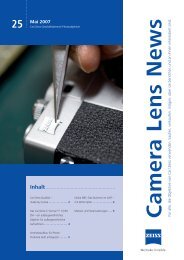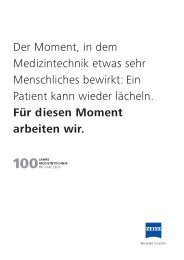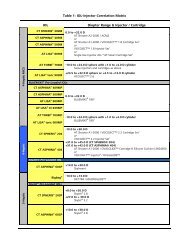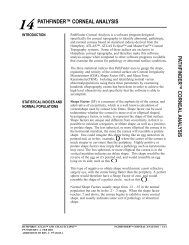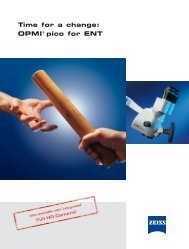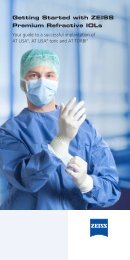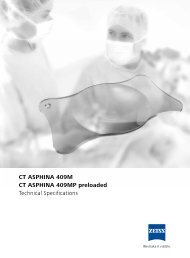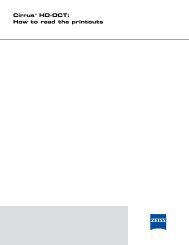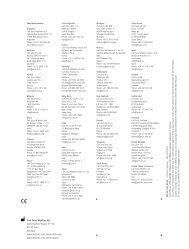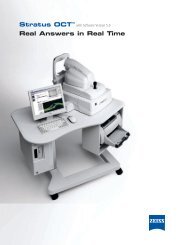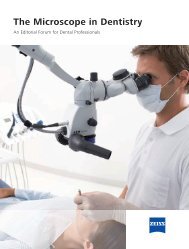ReLEx smile - Carl Zeiss Meditec AG
ReLEx smile - Carl Zeiss Meditec AG
ReLEx smile - Carl Zeiss Meditec AG
You also want an ePaper? Increase the reach of your titles
YUMPU automatically turns print PDFs into web optimized ePapers that Google loves.
<strong>ReLEx</strong> <strong>smile</strong><br />
Multicenter study results 2<br />
The following results were achieved within a controlled<br />
clinical study for <strong>ReLEx</strong> <strong>smile</strong> for the correction of myopia<br />
and astigmatism. 269 eyes with a preoperative BCVA of<br />
20/20 or better from three study centers (Denmark, India<br />
and Egypt) were analyzed and evaluated.<br />
pre-op CDVA 1 week 3 month 3 month<br />
Effectiveness: Visual outcome shows high rates of 20/20 UDVA. Stability: almost no regression over time.<br />
Excellent predictablity, results very close to target refraction, even for high<br />
myopic corrections<br />
»<br />
<strong>ReLEx</strong> is an interesting and an exciting new paradigm<br />
shift in refractive surgery that we are going to be<br />
able to be part of.<br />
Dr. Rupal Shah, New Vision Laser Centers, India, June 2012<br />
• 85 % of all patients achieved uncorrected visual acuity<br />
of 20/20 and better after 3 months<br />
• Stability with almost no regression<br />
• Results are very close to target refraction<br />
• For 97 % of eyes refractive outcome is within +/- 0,5 D<br />
Refractive outcomes within ±0.5 D for 97 % of eyes<br />
2 Reference see page 11 3 Reference see page 11<br />
97 %<br />
<strong>ReLEx</strong> flex<br />
Long-term study results 3<br />
Prof. Marcus Blum (Germany) and Prof. Walter Sekundo<br />
(Germany) belong to the small group of principal investigators<br />
for the VisuMax ® femtosecond laser and were deeply involved<br />
in the development of the lenticule extraction technique<br />
<strong>ReLEx</strong>. They have published the 5-year results of the initial<br />
<strong>ReLEx</strong> flex cases treated in 2006 as part of the approval study<br />
– including the first eyes ever treated – and conclude:<br />
Safety: Change in CDVA: 97 % of eyes no loss of lines; 72 % of eyes<br />
even gained lines<br />
Stability: Almost no regression over time.<br />
Please note that the treatments were aimed for slight undercorrection<br />
»<br />
Our 5-years results confirm <strong>ReLEx</strong> flex to be a<br />
predictable, safe and stable procedure for correction<br />
of myopia and myopic astigmatism.<br />
Prof. Walter Sekundo, Department of Ophthalmology,<br />
Philipps University Marburg, Germany, August 2012<br />
• <strong>ReLEx</strong> is a safe and effective procedure<br />
for treatment of myopia<br />
• High stability with negligible regression<br />
• Good refractive outcome<br />
• High patient satisfaction<br />
Efficacy: 77 % of eyes achieved UCVA of 20/20 or better; 88 % of eyes have an<br />
UCVA of 20/25 or better<br />
» »<br />
References<br />
Source 1<br />
Source 2<br />
Source 3<br />
Source 4<br />
Source 5<br />
Source 6<br />
Source 7<br />
Source 8<br />
Source 9<br />
Source 10<br />
Source 11<br />
Ekktet Chansue, TRSC International LASIK Center, Thailand,<br />
data on file, 2012 (page 3)<br />
Jesper Hjortdal, Rupal Shah, Osama Ibrahim, Controlled<br />
Multicenter Study, data on file, 2011 (fold-out page)<br />
Walter Sekundo, Philipps University Marburg, Germany,<br />
“<strong>ReLEx</strong> ® flex Treatments of Myopia using <strong>Carl</strong> <strong>Zeiss</strong> <strong>Meditec</strong><br />
Femtosecond Laser VisuMax ® “, DGII Berlin, 2012<br />
(fold-out page)<br />
Eui-Sang Chung, Samsung Medical Center, Korea, “Would it be<br />
possible to replace LASIK by <strong>ReLEx</strong>?”, ZEISS International<br />
Refractive Symposium, Hangzhou, 2012 (page 4)<br />
Dan Z. Reinstein, London Vision Clinic, United Kingdom,<br />
“Corneal sensitivity and biomechanical influence on spherical<br />
aberration induction”, International Refractive User Symposium,<br />
Cyprus, 2012, personal communication 2012 (page 5)<br />
Kumano Y, Matsui H, Zushi I, Mawatari A, Matsui T, Nishida T,<br />
Miyazaki M. Recovery of corneal sensation after myopic<br />
correction by laser in situ keratomileusis with a nasal or superior<br />
hinge. J Cataract Refract Surg. 2003,29(4):757-761 (page 5)<br />
Donnenfeld ED, Ehrenhaus M, Solomon R, Mazurek J, Rozell JC,<br />
Perry HD. Effect of hinge width on corneal sensation and dry<br />
eye after laser in situ keratomileusis. J Cataract Refract Surg.<br />
2004,30(4):790-797 (page 5)<br />
Bragheeth MA, Dua HS. Corneal sensation after myopic and<br />
hyperopic LASIK: clinical and confocal microscopic study. Br J<br />
Ophthalmol. 2005,89(5):580-585 (page 5)<br />
Kalyvianaki MI, Katsanevaki VJ, Kavroulaki DS, Kounis GA,<br />
Detorakis ET, Pallikaris IG. Comparison of corneal sensitivity and<br />
tear function following Epi-LASIK or laser in situ keratomileusis<br />
for myopia. Am J Ophthalmol. 2006,142(4):669-671 (page 5)<br />
Lee SJ, Kim JK, Seo KY, Kim EK, Lee HK. Comparison of corneal<br />
nerve regeneration and sensitivity between LASIK and laser<br />
epithelial keratomileusis (LASEK). Am J Ophthalmol.<br />
2006,141(6):1009-1015 (page 5)<br />
Mian SI, Shtein RM, Nelson A, Musch DC. Effect of hinge<br />
position on corneal sensation and dry eye after laser in situ<br />
keratomileusis using a femtosecond laser. J Cataract Refract<br />
Surg. 2007,33(7):1190-1194 (page 5)<br />
Source 12<br />
Source 13<br />
Source 14<br />
Source 15<br />
Source 16<br />
Source 17<br />
Source 18<br />
Source 19<br />
Source 20<br />
Mian SI, Li AY, Dutta S, Musch DC, Shtein RM. Dry eyes and<br />
corneal sensation after laser in situ keratomileusis with<br />
femtosecond laser flap creation. Effect of hinge position, hinge<br />
angle, and flap thickness. J Cataract Refract Surg.<br />
2009,35(12):2092-2098 (page 5)<br />
Nejima R, Miyata K, Tanabe T, Okamoto F, Hiraoka T, Kiuchi T,<br />
Oshika T. Corneal barrier function, tear film stability, and<br />
corneal sensation after photorefractive keratectomy and laser<br />
in situ keratomileusis. Am J Ophthalmol. 2005,139:64-71<br />
(page 5)<br />
Nassaralla BA, McLeod SD, Nassaralla JJ, Jr. Effect of myopic<br />
LASIK on human corneal sensitivity. Ophthalmology.<br />
2003,110:497-502 (page 5)<br />
Cynthia Roberts, Ohio State University, “Biomechanical<br />
advantages of <strong>ReLEx</strong> <strong>smile</strong> as a refractive procedure”,<br />
International Refractive User Symposium, Cyprus, 2012,<br />
personal communication 2012 (page 6)<br />
Dan Z. Reinstein, London Vision Clinic, United Kingdom,<br />
“Corneal sensitivity and biomechanical influence on spherical<br />
aberration induction”, International Refractive User Symposium,<br />
Cyprus, 2012, personal communication 2012 (page 7)<br />
Randleman et al, Depth-dependent cohesive tensile strength<br />
in human donor corneas: implications for refractive surgery.<br />
J Refract. Surg. 2008 Jan, 24 (1): S. 85 – 89 (page 7)<br />
Knox Cartwright NE, Tyrer JR, Jaycock PD, Marshall J, ”The effect<br />
of variation in depth and side cut angulation in sub-Bowman’s<br />
keratomileusis and LASIK using a femtosecond laser:<br />
a biomechanical study”, Journal of Refractive Surgery, 2012<br />
(in press) (page 7)<br />
Dan Z. Reinstein, London Vision Clinic, United Kingdom,<br />
personal communication 2012 (page 8, 9)<br />
Sonia Yoo, Bascom Palmer Eye Institute, USA, Lenticule Imaging<br />
Project: Surface Quality of Extracted SMILE Lenticules Using<br />
“Environmental” SEM Technique, AAO Orlando 2011, CZM<br />
Evening Symposium (page 10)<br />
11



